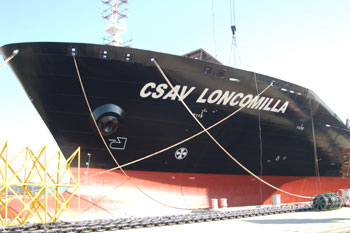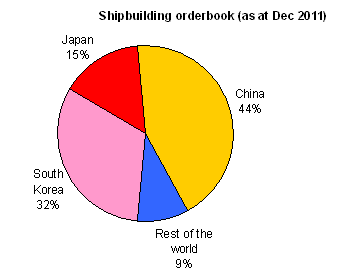
IN THE face of a worsening downturn in the shipping industry, Mr Tan Zuojun, the President of China’s largest shipbuilder, China State Shipbuilding Corp, cautions that as many as half of China's shipyards face bankruptcy. He also has good news though: The fittest will grow stronger and gain market share. NextInsight has translated below a CCTV interview with Mr Tan.
WHAT DOES the slowdown in the global shipbuilding industry augur for China, given that it is now the world’s largest shipbuilder by deadweight tonnage output? As the No.1 player, China has set records for new orders clinched and has the world’s largest order book.
Even with these feathers in the cap, Tan Zuojun, chairman of China State Shibuilding Corp (market cap: RMB 30 billion, listed on Shanghai Stock Exchange) conceded that China’s shipbuilding industry lacks technological edge.
While he believes that the Chinese players' technology will advance, he cautions about the looming possibility of a wave of bankruptcies among uncompetitive shipyards.
Since the beginning of 2011, there have been rumors that there would be another round of restructuring and consolidation in the industry.
However, Mr Tan thinks that this year is too early for an industry consolidation. He believes that it whould not happen before next year, but that is likely to be preceded by a wave of bankruptcies.
Bankruptcies of shipyards had in fact started during the global financial crisis two years back. There are still yards around that are on the verge of bankruptcy. The yards that eventually survive are those with a strong order book that will tide them through this crisis.
More likely than not, they will declare bankruptcy because these yards are not even good enough for restructuring.
Whether these uncompetitive yards make or break depends on how well they do this year.

Small yards that opened and expanded during the boom are the worst hit
Mr Tan cautions that as many as 50% of China’s shipyards may shut down over the next two to three years.
A myriad of factors will cause these bankruptcies.
Firstly, most shipyards in China are small medium enterprises and are new entrants to the shipbuilding industry.
The owners did not invest sufficient capital and the yards therefore have limited facilities and equipment.
Such yards entered the industry during the shipbuilding boom and inevitably fold in a downturn as the lucrative profits disappear.
Then, at the the other extreme, are yards that expanded shipbuilding facilities furiously and yet remain uncompetitive. These are also likely to shut down.

Thirdly, some yards did not manage their newbuilding product specifications well when the contract was signed, giving rise to serious problems during vessel delivery. They got into serious financial problems as a result.
Some other yards opened during the boom and did not manage to secure sufficient newbuilding orders to stay afloat.
“In this chaotic situation, large yards with competitive advantage will survive and grow even stronger,” said Mr Tan.
Two trends will dominate the shipbuilding industry this year, he said.
Firstly, new orders will go mainly to the competitive yards. Secondly, shipyards have to manage their cost of R&D for new technology very well. Yards without strong management to steer them through the rough seas will sink into oblivion.
Recent story: XINREN 'extremely undervalued', ARA's target upped, YANGZIJIANG a potential 3-bagger







